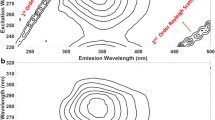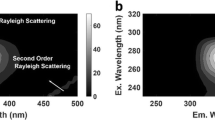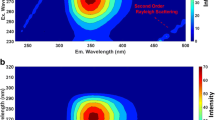Abstract
Excitation emission matrix fluorescence (EEMF) spectroscopy is a multiparametric fluorescence technique where the fluorescence intensity of a fluorophore is a function of excitation wavelength, emission wavelength and its concentration. The manual analysis of large volume of highly correlated EEMF data sets towards developing a calibration model for quantifying each fluorophores present in multifluorophoric mixtures is a difficult and time-consuming task. Over the years, Partial least square (PLS) algorithm has found its application towards providing swift and efficient analyses of large volumes of highly correlated spectral data sets. The PLS assisted EEMF spectroscopy has been successfully used towards quantifying the fluorophores in multifluorophoric mixtures without involving any pre-separation. However, the accuracy and robustness of developed calibration model can be significantly improved provided PLS analysis is carried out on the analytically relevant EEMF spectral variables. In the present work, a variable selection method baptized as simple variable selection (SVS) approach is introduced that provides a simple and computationally economical means of identifying the useful spectral variables for subsequent PLS analysis. The proposed SVS approach is successfully validated by analyzing the complex EEMF data sets of multifluorophoric mixtures of consisting of multifluorophoric mixtures of biological relevance. The proposed approach is found to provide a simple, swift and efficient means for developing a robust PLS assisted EEMF spectroscopy based calibration model for simultaneous quantification of various fluorophores present in multifluorophoric mixtures.






Similar content being viewed by others
References
Rho JH, Stuart JL (1978) Automated three-dimensional plotter for fluorescence measurements. Anal Chem 50:620–625
Freegarde M, Hatchard CG, Parker CA (1971) Oil spilt at sea: its identification, determination, and ultimate fate. Lab Pr 20:35–40
Warner IM, Callis JB, Davidson ER, Goutermann M, Christian GD (1975) Fluorescence analysis: a new approach. Anal Lett 8:665–681
Kumar K, Tarai M, Mishra AK (2017) Unconventional steady-state fluorescence spectroscopy as an analytical technique for analyses of complex-multifluorophoric mixtures. TrAC Trends Anal Chem 97:216–243
Kumar K, Mishra AK (2013) Analysis of dilute aqueous multifluorophoric mixtures using excitation-emission matrix fluorescence (EEMF) and total synchronous fluorescence (TSF) spectroscopy: a comparative evaluation. Talanta 117:209–220
Kramer R (1998) Chemometric techniques for quantitative analysis. Marcel Dekker, New York
Wold S, Ruhe A, Wold H, Dunn WJ (1984) The collinearity problem in linear regression. The partial least squares (PLS) approach to generalized inverses. SIAM J Sci and Stat Comp 5:735–743
Geladi P, Kowalski B (1986) Partial least square regression: a tutorial. Anal Chim Acta 185:1–17
Lorber A, Wangen LE, Kowalski BR (1987) A theoretical foundation for the PLS algorithm. J Chemom 1:19–31
Varmuza K, Filzmoser P (2008) Introduction to multivariate statistical analysis in chemometrics. Taylor & Francis Group, Boca Raton, FL
Sorol N, Arancibia E, Bortolato SA, Olivieri AC (2010) Visible/near infrared-partial least-squares analysis of brix in sugar cane juice a test field for variable selection methods. Chemom Intell Lab Syst 102:100–109
Goicoechea HC, Olivier AC (2003) A new family of genetic algorithms for wavelength interval selection in multivariate analytical spectroscopy. J Chemom 17:338–345
Mehmood T, Liland KH, Snipen L, Sæbø S (2012) A review of variable selection methods in partial least squares regression. Chemom Intell Lab Syst 118(2012):62–69
Shaffer RE, Small GW (1996) Genetic algorithm-based protocol for coupling digital filtering and partial least-squares regression: application to the near-infrared analysis of glucose in biological matrices. Anal Chem 68:2663–2675
Ding Q, Small GW (1998) Genetic algorithm-based wavelength selection for the near-infrared determination of glucose in biological matrixes: initialization strategies and effects of spectral resolution. Anal Chem 70:4472–4479
Bangalore AS, Shaffer RE, Small GW (1996) Genetic algorithm based method for selecting wavelengths and model size for use with partial least-squares regression: application to near-infrared spectroscopy. Anal Chem 68:4200–4212
Xiaobo Z, Jiewen Z, Hanpin M, Jiyong S, Xiaopin Y, Yanxiao L (2010) Genetic algorithm interval partial least squares regression combined successive projections algorithm for variable selection in near-infrared quantitative analysis of pigment in cucumber leaves. Appl Spectrosc 64:786–794
Leardi R, González AL (1998) Genetic algorithms applied to feature selection in PLS regression: how and when to use them. Chemom Intell Lab Syst 41:195–207
Fujiwara K, Sawada H, Kano M (2012) Input variable selection for PLS modelling using nearest correlation spectral clustering. Chemom Intell Lab Syst 118:109–119
Arakawa M, Yamashita Y, Funatsu K (2010) Genetic algorithm-based wavelength selection method for spectral calibration, J. Chemom 25:10–19
Chong IG, Jun CH (2005) Performance of some variable selection methods when multicollinearity is present. Chemom Intell Lab Syst 78:103–112
Rajalahti T, Arnebergc R, Bervend FS, Myhra KM, Ulvikd RJ, Kvalheimg OM (2009) Biomarker discovery in mass spectral profiles by means of selectivity ratio plot. Chemom Intell Lab Syst 95:35–48
Hocking RR (1976) The analysis and selection of variables in linear regression. Biometrics 32:1–49
Kumar K, Mishra AK (2012) Application of parallel factor analysis to total synchronous fluorescence spectrum of dilute multifluorophoric solutions: addressing the issue of lack of trilinearity in total synchronous fluorescence data set. Anal Chim Acta 755:37–45
Wise BM, Gallaghar NB, Bro R, Shaver JM (2006) PLS_Toolbox 4.0. Eigen vector research
Kumar K, Mishra AK (2012) Quantification of ethanol in ethanol petrol and biodiesel in biodiesel-diesel blends using fluorescence spectroscopy and multivariate methods. J Fluoresc 22:339–347
Author information
Authors and Affiliations
Corresponding author
Rights and permissions
About this article
Cite this article
Kumar, K. Introducing ‘Simple Variable Selection (SVS) Approach’ for Improving the Quantitative Accuracy of Chemometric Assisted Fluorimetric Estimations of Dilute Aqueous Mixtures. J Fluoresc 28, 1163–1171 (2018). https://doi.org/10.1007/s10895-018-2280-x
Received:
Accepted:
Published:
Issue Date:
DOI: https://doi.org/10.1007/s10895-018-2280-x




